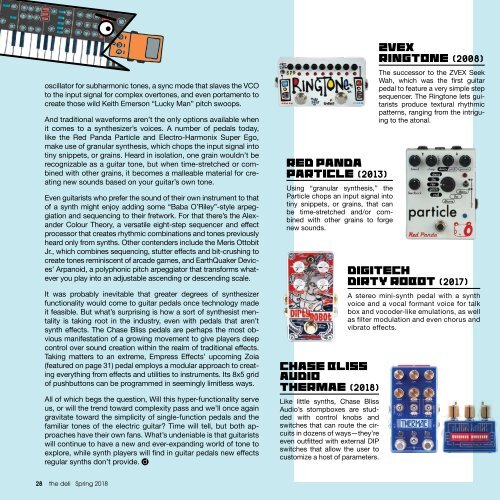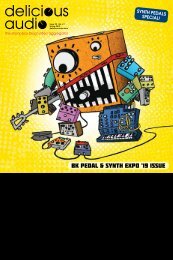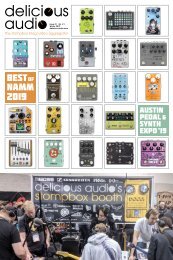Deli #54 - Bodega, Brooklyn Stompbox Exhibit and Synth Expo 2018
A magazine and website focused on emerging NYC artists and pedals!
A magazine and website focused on emerging NYC artists and pedals!
You also want an ePaper? Increase the reach of your titles
YUMPU automatically turns print PDFs into web optimized ePapers that Google loves.
oscillator for subharmonic tones, a sync mode that slaves the VCO<br />
to the input signal for complex overtones, <strong>and</strong> even portamento to<br />
create those wild Keith Emerson “Lucky man” pitch swoops.<br />
And traditional waveforms aren’t the only options available when<br />
it comes to a synthesizer’s voices. A number of pedals today,<br />
like the Red P<strong>and</strong>a Particle <strong>and</strong> Electro-Harmonix Super Ego,<br />
make use of granular synthesis, which chops the input signal into<br />
tiny snippets, or grains. Heard in isolation, one grain wouldn’t be<br />
recognizable as a guitar tone, but when time-stretched or combined<br />
with other grains, it becomes a malleable material for creating<br />
new sounds based on your guitar’s own tone.<br />
Even guitarists who prefer the sound of their own instrument to that<br />
of a synth might enjoy adding some “Baba O’Riley”-style arpeggiation<br />
<strong>and</strong> sequencing to their fretwork. For that there’s the Alex<strong>and</strong>er<br />
Colour Theory, a versatile eight-step sequencer <strong>and</strong> effect<br />
processor that creates rhythmic combinations <strong>and</strong> tones previously<br />
heard only from synths. Other contenders include the meris Ottobit<br />
Jr., which combines sequencing, stutter effects <strong>and</strong> bit-crushing to<br />
create tones reminiscent of arcade games, <strong>and</strong> EarthQuaker Devices’<br />
Arpanoid, a polyphonic pitch arpeggiator that transforms whatever<br />
you play into an adjustable ascending or descending scale.<br />
It was probably inevitable that greater degrees of synthesizer<br />
functionality would come to guitar pedals once technology made<br />
it feasible. But what’s surprising is how a sort of synthesist mentality<br />
is taking root in the industry, even with pedals that aren’t<br />
synth effects. The Chase Bliss pedals are perhaps the most obvious<br />
manifestation of a growing movement to give players deep<br />
control over sound creation within the realm of traditional effects.<br />
Taking matters to an extreme, Empress Effects’ upcoming Zoia<br />
(featured on page 31) pedal employs a modular approach to creating<br />
everything from effects <strong>and</strong> utilities to instruments. Its 8x5 grid<br />
of pushbuttons can be programmed in seemingly limitless ways.<br />
All of which begs the question, Will this hyper-functionality serve<br />
us, or will the trend toward complexity pass <strong>and</strong> we’ll once again<br />
gravitate toward the simplicity of single-function pedals <strong>and</strong> the<br />
familiar tones of the electric guitar? Time will tell, but both approaches<br />
have their own fans. What’s undeniable is that guitarists<br />
will continue to have a new <strong>and</strong> ever-exp<strong>and</strong>ing world of tone to<br />
explore, while synth players will find in guitar pedals new effects<br />
regular synths don’t provide. d<br />
red P<strong>and</strong>a<br />
ParTiCle (2013)<br />
Using “granular synthesis,” the<br />
Particle chops an input signal into<br />
tiny snippets, or grains, that can<br />
be time-stretched <strong>and</strong>/or combined<br />
with other grains to forge<br />
new sounds.<br />
ChaSe bliSS<br />
audio<br />
Thermae (<strong>2018</strong>)<br />
Like little synths, Chase Bliss<br />
Audio’s stompboxes are studded<br />
with control knobs <strong>and</strong><br />
switches that can route the circuits<br />
in dozens of ways—they’re<br />
even outfitted with external DIP<br />
switches that allow the user to<br />
customize a host of parameters.<br />
zVex<br />
rinGTone (2008)<br />
The successor to the ZVEX Seek<br />
Wah, which was the first guitar<br />
pedal to feature a very simple step<br />
sequencer. The Ringtone lets guitarists<br />
produce textural rhythmic<br />
patterns, ranging from the intriguing<br />
to the atonal.<br />
diGiTeCh<br />
dirTy roboT (2017)<br />
A stereo mini-synth pedal with a synth<br />
voice <strong>and</strong> a vocal formant voice for talk<br />
box <strong>and</strong> vocoder-like emulations, as well<br />
as filter modulation <strong>and</strong> even chorus <strong>and</strong><br />
vibrato effects.<br />
28 the deli Spring <strong>2018</strong>







